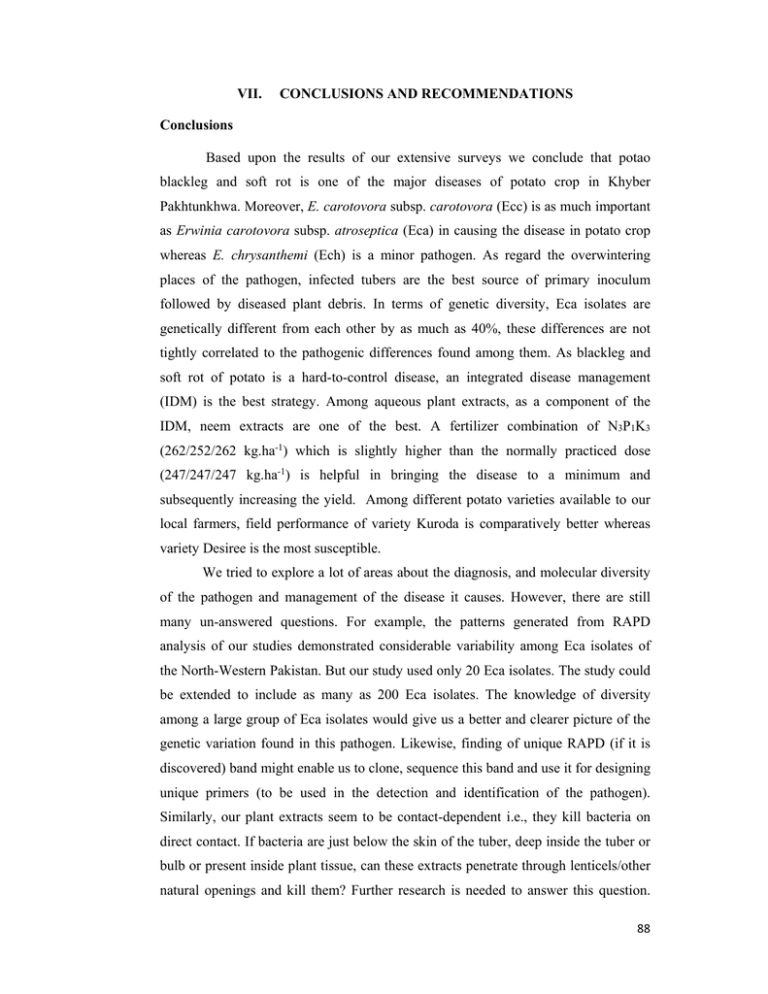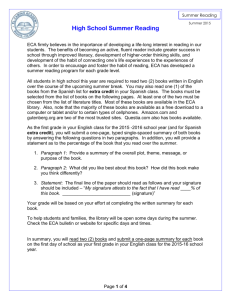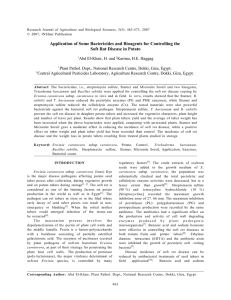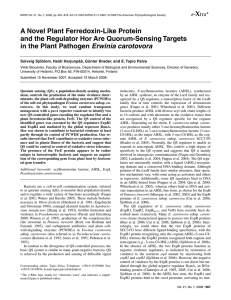VII. CONCLUSIONS AND RECOMMENDATIONS Conclusions
advertisement

VII. CONCLUSIONS AND RECOMMENDATIONS Conclusions Based upon the results of our extensive surveys we conclude that potao blackleg and soft rot is one of the major diseases of potato crop in Khyber Pakhtunkhwa. Moreover, E. carotovora subsp. carotovora (Ecc) is as much important as Erwinia carotovora subsp. atroseptica (Eca) in causing the disease in potato crop whereas E. chrysanthemi (Ech) is a minor pathogen. As regard the overwintering places of the pathogen, infected tubers are the best source of primary inoculum followed by diseased plant debris. In terms of genetic diversity, Eca isolates are genetically different from each other by as much as 40%, these differences are not tightly correlated to the pathogenic differences found among them. As blackleg and soft rot of potato is a hard-to-control disease, an integrated disease management (IDM) is the best strategy. Among aqueous plant extracts, as a component of the IDM, neem extracts are one of the best. A fertilizer combination of N3P1K3 (262/252/262 kg.ha-1) which is slightly higher than the normally practiced dose (247/247/247 kg.ha-1) is helpful in bringing the disease to a minimum and subsequently increasing the yield. Among different potato varieties available to our local farmers, field performance of variety Kuroda is comparatively better whereas variety Desiree is the most susceptible. We tried to explore a lot of areas about the diagnosis, and molecular diversity of the pathogen and management of the disease it causes. However, there are still many un-answered questions. For example, the patterns generated from RAPD analysis of our studies demonstrated considerable variability among Eca isolates of the North-Western Pakistan. But our study used only 20 Eca isolates. The study could be extended to include as many as 200 Eca isolates. The knowledge of diversity among a large group of Eca isolates would give us a better and clearer picture of the genetic variation found in this pathogen. Likewise, finding of unique RAPD (if it is discovered) band might enable us to clone, sequence this band and use it for designing unique primers (to be used in the detection and identification of the pathogen). Similarly, our plant extracts seem to be contact-dependent i.e., they kill bacteria on direct contact. If bacteria are just below the skin of the tuber, deep inside the tuber or bulb or present inside plant tissue, can these extracts penetrate through lenticels/other natural openings and kill them? Further research is needed to answer this question. 88 Determination of the cost-benefit ratio as well as the precise identification of the active anti-microbial metabolites found in these plants need to be investigated. Research on the purification, characterization, formulation, activity period (time interval during which these anti-microbial metabolites are effective after their application as seed treatment, sprays or soil drenches) and effective dosage of these plant metabolites is also needed. Recommendations As infected tubers are the best source of primary inoculum, it is recommended that disease-free tubers should be used as source of seed. Alternatively, seed tubers should be treated with aquous plant extracts such as neem extracts to kill the tubersurface-borne inoculum. The finding that Eca isolates could genetically differ from each other by as much as 40% suggests that the pathogen is heterogeneous and could pose threat to breaking the resistance of resistant potato varieties. Therefore, it is recommended to have as many moderately resistant varieties as possible. On the control side, an integrated disease management (IDM) strategy is recommended. As a part of IDM, a fertilizer combination (NPK, 262/252/262 kg.ha-1) which is slightly higher than the normally practiced dose (NPK, 247/247/247 kg.ha-1) should be used. If acceptable to local farmers, the relatively less susceptible potato variety Kuroda (longer duration) should be used rather than the more susceptible shorter duration variety “Desiree”. 89



